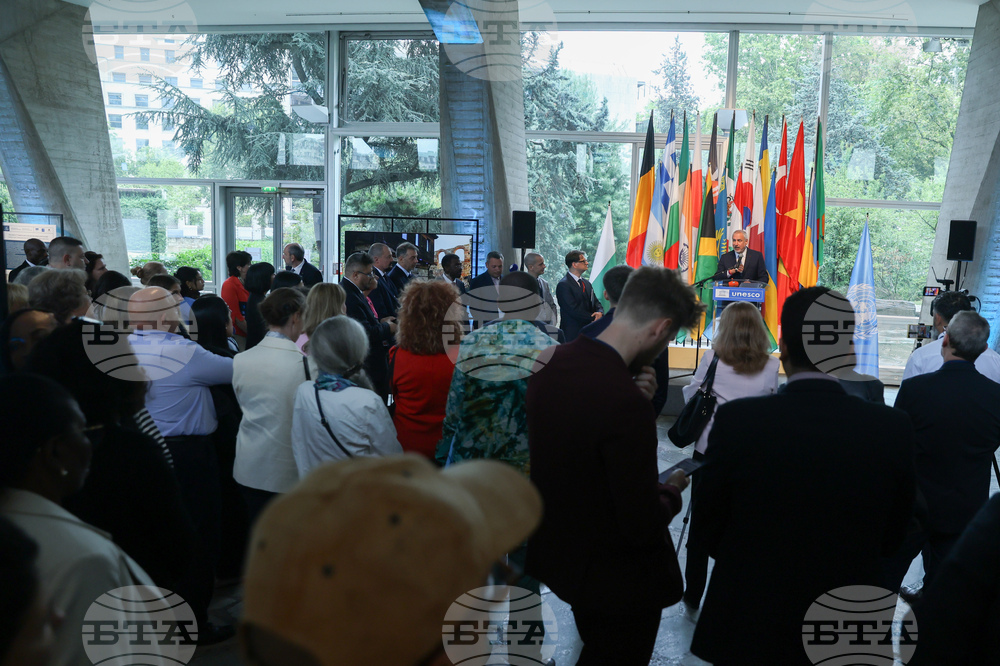site.btaExhibition Showcasing Black Sea Region's Cultural Heritage Opens at UNESCO HQ in Paris


The exhibition On the Waves of the Black Sea through the Ages officially opened in Hall Segur at UNESCO headquarters in Paris on Monday. The event is part of Bulgaria’s cultural programme during the 47th session of the UNESCO World Heritage Committee and showcases iconic archaeological artefacts that reflect the rich cultural heritage of the Black Sea region.
Speaking at the exhibition’s opening, Deputy Minister of Culture Todor Chobanov said: "When culture takes its place at the table, when heritage is appreciated and supported, we achieve real results. We are here with our courage – as archaeologists, scientists, and people who care about the past and envision the future – to share a message of partnership."
"The cultural achievements we present today are not solely ours. They are the result of thousands of years of history. Before us are masterpieces from diverse civilizations, diverse peoples and cultures that unite us in the global understanding of valuable cultural heritage is and why it is worth preserving," he added.
Chobanov noted that the Black Sea is a cultural phenomenon, a place where history and culture have revealed their depth and grandeur over the centuries. "Our colleagues from the Centre for Underwater Archaeology are here with us, alongside partners from across Europe and the world. They are working together to explore and protect this heritage for future generations. That is why we are presenting these beautiful and impressive artefacts here at UNESCO – so the entire world can see and appreciate them," he said.
UNESCO Assistant Director-General for Culture Ernesto Ottone said that the exhibition pays tribute to the artistic, cultural, and historical richness of the Black Sea basin. For millennia, this region has been shaped by the sea – through its traditions, trade, and intercultural exchanges, he said, adding that the Black Sea coast has served as a crossroads of civilizations, sitting at the intersection of Europe and Asia.
He noted that the efforts of Bulgarian researchers and experts had played a crucial role in uncovering this underwater cultural heritage. "Their work has revealed exceptional archaeological discoveries, including remarkable ships, artefacts, and finds that have been well-preserved. In this regard, the efforts to explore and preserve underwater cultural heritage should be highly appreciated," Ottone said.
He added that during a visit to Bulgaria, he was impressed to learn that the country has the highest number of women working in underwater archaeology – a field still dominated by men in many countries. He praised Bulgaria for its leadership in promoting gender equality in the profession.
Hristo Popov, Director of the National Archaeological Institute with Museum (NAIM) at the Bulgarian Academy of Sciences, said that the Black Sea has always played a vital role in the history of mankind. It is not just a geographical location. For millions of years, it has been a hub of contact, exchange, and transition between cultures and civilizations, he noted.
Popov added that archaeological evidence along the western Black Sea coast – present-day Bulgarian territory – includes traces of Europe’s earliest farming communities and some of humanity’s first boats. "Over the centuries, generations have left behind a wealth of cultural heritage. The Black Sea is an example of sustainable multicultural coexistence, where different peoples and cultures have interacted," he said.
The NAIM Director said that the exhibition is the result of collaborative efforts between the National Archaeological Institute, the Centre for Underwater Archaeology, and several Bulgarian museums. It aims to provide an overview of the rich history and cultural heritage of the western coast of the Black Sea, within the borders of modern Bulgaria. The exhibition covers a period of 10,000 years – from prehistory to the present – highlighting both terrestrial and underwater archaeology, the latter of which plays an increasingly vital role in contemporary research," Popov said.
The exhibition presents a wide range of valuable discoveries made during underwater and terrestrial excavations along Bulgaria’s Black Sea coast and is open to representatives of all member states that have sent delegations to the session.
Highlights include artefacts from the Temple of Cybele in Balchik and from ancient Apollonia Pontica (modern-day Sozopol), among others, illustrating the region’s flourishing culture across eras. The exhibition not only displays these discoveries but also provides a background of their discovery and the growing field of underwater archaeology in Bulgaria.
As part of the programme, a special evening event dedicated to underwater archaeology will feature Nayden Prahov, Director of the Centre for Underwater Archaeology. Bulgaria has also submitted a formal request for the Centre to be recognized as a UNESCO Category 2 institution, a move that would solidify this country’s leading role in this field, the Ministry of Culture said.
Held under the presidency of Bulgaria, the 47th session of the UNESCO World Heritage Committee began earlier on Monday and will continue until July 16 at UNESCO headquarters in Paris. Throughout the session, Bulgaria will showcase cultural and natural elements of its national heritage.
/RY/
Additional
news.modal.image.header
news.modal.image.text
news.modal.download.header
news.modal.download.text
news.modal.header
news.modal.text









